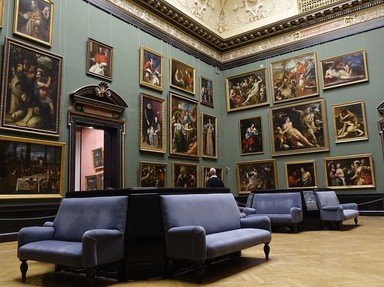Quiz Answer Key and Fun Facts
1. Our first exhibit dates to 1470. "Saint George and the Dragon" is one of the most spectacular interpretations of the famous story. This is one of the last works produced by a Late Gothic artist known for his colour and pageantry. Who is the artist?
2. Dating to 1435, "The Arnolfini Portrait" is a famous work by one of the most important Northern Renaissance artists of the period. Painted in oil on three oak panels, this fairly small (33"x24") full-length double portrait is considered one of the most original and complex paintings of early Western art. Who is the Netherlandish artist?
3. Housed in the National Gallery since 1844, this 1636 work is one of numerous versions of "The Judgement of Paris" painted by this Flemish Baroque artist. The two most famous are the two large versions, this one and another painted two years later that hangs in the Prado in Madrid. Who is the artist?
4. Presented to the National Gallery in 1934, "The Graham Children" is a 1742 portrait of the family of Daniel Graham, King George II's apothecary. Although an accomplished portraitist, this artist is perhaps best-known as a cartoonist and pictorial satirist. Who is the English artist?
5. Previously housed at the Tate Gallery, "Miss La La at the Cirque Fernando" was returned to the National Gallery in 1950. Set at the Cirque Fernando in Montmartre in northern Paris, the painting depicts the celebrated acrobat hanging on a rope by just her teeth. Which of the great Impressionists was the artist?
6. The artist painted two very similar versions of "Virgin of the Rocks", both more than six feel high. The version on display at the National Gallery is the latter of the two, painted between 1495 and 1508, some 15 years after the original, which hangs in The Louvre. Who is the Early Renaissance artist?
7. We fast-forward almost four centuries to another work that has multiple versions, "Wheat Field with Cypresses" painted in 1889. Another almost identical version hangs in the Metropolitan Museum of Art in New York. These were painted in the Saint-Paul-de-Mausole mental asylum near Arles on France's Mediterranean coast. Who is the artist?
8. Once part of one of the great royal art collections of Europe, owned by the Duke of Orleans, "The Origin of the Milky Way" was painted in the late 1570s. Who is the Renaissance artist from the Venetian School?
9. Many artists have painted their interpretation of "The Adoration of the Magi". This variation on that theme is a 1564 oil on panel by a Netherlandish Renaissance painter and printmaker probably best-known for his genre paintings. Who is the artist?
10. We've reached the end of our selection of great works from the National Gallery in London, and yet we have barely scratched the surface. "The Cornfield", a 56"x48" masterpiece dating to 1826 typifies both this wonderful collection and the work of which iconic English Romantic painter?
Source: Author
EnglishJedi
This quiz was reviewed by FunTrivia editor
looney_tunes before going online.
Any errors found in FunTrivia content are routinely corrected through our feedback system.

